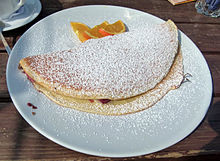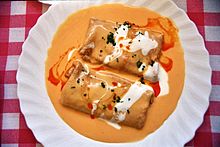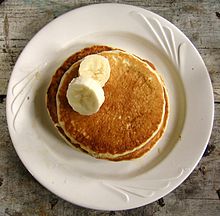pancakes
Pancakes or omelettes , as crepes, pancakes and pancake, egg dishes from eggs , milk and flour , in a pan baked. Pancakes and pancakes differ from omelets because they are bonded with flour . There are sweet pancakes and savory egg dishes (e.g. ham pancakes). In the sweet versions, the sugar content in the dough is higher.
Concept history
As early as 1918, the linguist Paul Kretschmer discovered that pancakes are flat, round cakes made from milk and eggs with more or less flour that are quickly baked in a pan. Originally both concepts existed well pretty much anywhere in Germany side by side: pancakes as a predominantly existing cake made with eggs, however, pancakes cake mainly of flour. In Berlin and the surrounding area, the pancake was and is a spherical donut . From Berlin, the "Berlin pancake" was also taken over in Prussia and completely replaced the term pancake for flat pancakes or pancakes in the greater Berlin area . In the entire German-speaking area the term P [f] ann [e / n] kuche [n] is more widespread, egg cakes is the less common but also widespread form, regionally the dish is also called Plinse , Palatschinke or Om [e] lett . The various terms are used in the specialist literature.
preparation
Pierer's Universal Lexikon from 1848 described the pancake as follows:
“ Pancakes , a pastry made from milk, fine flour, eggs, a little sugar, etc. a few grains of salt; this is whisked all together in a pot and bakes it in a dough, in melted lard or bacon, in a few minutes over a gentle heat, browning on both sides; with sugar and They are usually sprinkled on the table with sweet sauces or salads. "
The basic recipe for pancake batter consists of wheat flour, whole milk (cream or buttermilk), whole egg, sugar, butter, a pinch of salt, grated unsprayed lemon and orange peel, depending on your taste. Using a ladle, pour the mixture into a hot, greased frying pan and sear it on both sides until the pancake takes on a more or less light brown color, depending on your taste.
For better mixing, the liquid ingredients are usually mixed intensively, salt dissolved in them and then the liquid is thickened with flour. In some variants, the egg white and yolk are separated beforehand and egg whites are added later. The dough is usually left to “rest” for a while to allow the swellable ingredients to swell ( dough resting ). Afterwards, flatbreads are baked in portions in hot fat or oil, usually on both sides (turned) in a pan, unless the pancakes are being prepared on fixed, heated plates (see also crêpière ) (the dough is spread out with a so-called dough rake).
German-style pancakes (French: pannequets allemande ) are baked in a large pan in the oven.
variants

Depending on the area of distribution, tradition and ingredients used, there are variants that taste neutral, sweet or salty. Accordingly, salt , sugar , herbs and spices are added to the dough . Instead of milk, other liquids such as buttermilk , cream , beer , soda or mineral water are used. The addition of carbonated liquids loosens the dough, while the addition of cooking oil or cream can prevent it from sticking to the pan. Some recipes also contain raisins or finely grated peel of lemons and oranges. Wheat flour with a very high degree of grinding is usually used to prepare the dough ; the smaller the particle size of the flour, the thinner the dough cakes can be made. Buckwheat , millet and other types of grain, as well as other starchy ingredients, for example flours or pastes made from chickpeas , potatoes or chestnuts , are also used regionally .
In contrast to light French crepes , pancakes usually have less liquid and higher egg or flour content, which makes the dough much thicker. They are also baked darker (with the help of sugar in the batter).
- The normal pancake is served with applesauce , jam , sweet spreads and / or icing sugar and cinnamon, and is often rolled, cut in half or quartered. However, the variety of toppings is increasing - not least due to the influence of the crêpes.
- There are also variations in which fruit is baked into the pancake. Cherries or blueberries are popular, and the version with apples (apple pancake) is very popular . Blueberries should not be stirred into the batter, as the anthocyanin dye of damaged berries in the alkaline environment can lead to an unsightly green coloration of the entire mass.
- A popular salty variant is bacon pancakes , which use fried bacon cubes or strips. Green salad is often served with it.
- Salty ingredients such as cheese or bacon are often combined with sweet ingredients (usually fruit). One example is the apple and bacon pancake.
- The combination with fresh herbs that are added to the dough is also popular. For example, chives , wild garlic or parsley are used . This variant is often eaten with asparagus dishes or as a soup.
- Other non-sweet varieties include cheese or seared mushrooms.
- With the pancake , the dough is not baked into thin flat cakes, but turned, stirred or turned over and over like a Kaiserschmarrn , so that small pieces are created. This variant is popular in Franconia .
Regional particularities
Central and Eastern Europe
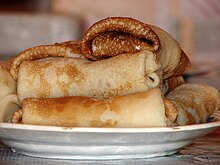

- In Brandenburg regions, particularly the Altmark , pancakes along with a green-bean - stew eaten.
- Bliny or blini are a tradition in Russia . They are often made entirely or partially from buckwheat or millet flour instead of wheat flour, and yeast is often used. Bliny are roughly the same as plins from Lausitz and Saxony and are usually eaten with butter and salt, but also with sour cream and caviar. Russian oladji , on the other hand, are thicker and are made with sour milk instead of yeast.
- Pancakes , (singular: the pancakes [palaˈtʃɪŋkə] , but mostly in the plural, Romanian clătite and Hungarian palacsinta from Latin placenta , "cake") are thinner and finer than the usual pancake. Except in today's Austria , they are prepared and eaten in all countries and areas of the former empire Austria or Austria-Hungary, both sweet and savory, for example in the Czech Republic , Hungary , Romania ( clătite ), in Slovakia ( palacinky ), im former Yugoslavia ( palačinke or palačinci ) and generally in the Balkans ( Bulgaria - палачинка ( palatschinka ), pl. палачинки ( palatschinki )). Preheated jam (often apricot jam ), curd cheese , grated nuts (mainly roasted hazelnuts or walnuts ), fruit , coconut flakes, chocolate , nut nougat cream , but also steamed vegetables such as spinach or preparations made from minced meat or soft cheese are used as filling . Sometimes they are offered as ice pancakes filled with ice cream (but should not be confused with omelette surprise ). A topping is only used for decoration, not as a coating. Sweet pancakes are also refined with spirits like a Crêpe Suzette . Also named after Karl Gundel as Gundel pancakes , they are often offered. Occasionally, rolled or unrolled pancakes are baked in the oven afterwards, similar to lasagne . Hortobágyi húsos palacsinta is common in Hungary . These are pancakes filled with minced meat, served with a paprika sauce and a little sour cream.
- In Poland , on the one hand, naleśniki are known - these are comparable to Bohemian pancakes and German pancakes, but are often filled with white cheese (quark) or blueberries, folded and then browned in butter. On the other hand, there are the Polish racuchy , thicker yeast pancakes, often with embedded fruit such as pieces of apple or blueberries. They are originally related to Bliny and Plinsen and externally resemble the Russian Oladji .
- Dalken from the Bohemian-Austrian-Bavarian cuisine basically correspond to the Polish racuchy , but are smaller and are baked in pans with special recesses. Another Czech name for them is Lívance , translated to Liwanzen in Austria and Old Bavaria .
- In Baden, people like to eat vegetables such as kohlrabi , cauliflower or asparagus in a light sauce that is rolled up with pancakes .
- In Swabia, pancakes ( Flädle : "small flatbread ") are also cut into narrow strips and used as a filler for Flädleuppe . In Austria , these soups is made nudelig cut, without sugar cooked pancakes pancake called. The soup served in this way (usually a beef soup ) is called fry soup . In old Bavaria this soup is called pancake soup . Usually extra pancakes are prepared with no added sugar, only in domestic consumption are leftovers of sweet pancakes.
- In the Bavarian- Austrian Schmarr (e) n (the word goes back to the Upper German word for smear), Eierschmarren or Kaiserschmarrn , the pancake is prepared with beaten egg whites and chopped up in the pan while it is setting or before serving. Likewise with the Swabian and Baden Kratzete .
- In the Lüneburg Heath , pancakes made from buckwheat flour are served with blueberries .
- In the Eifel , hearty "Hedelich Pankech" is prepared with buckwheat flour (but not necessarily eggs), which is served with soups, stews or meat dishes.
- In East Friesland and Groningen , the thickness of bacon , which consists of a mixture of rye and wheat meal or buckwheat flour, is popular. They are traditionally eaten there between Christmas and New Year's Eve.
Western and Southern Europe
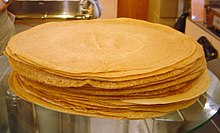
- A crepe is a tender, very thin pancake from France, which is baked on the crepière . A similar type of preparation is called crespella in Italy.
- Poffertjes are Dutch relatives of the Bohemian-Austrian Dalken, but originally from France. Approx. 15 to 20 pancakes, which are no more than 4 cm in diameter, are baked in special pans with the appropriate indentations. They are usually served with butter and powdered sugar.
- The crêpe-like flensjes , very thin pancakes usually eaten with powdered sugar or jam, also come from the Netherlands .
- Galette is the Breton (mostly hearty) variant of buckwheat flour crêpes.
- Farinata (also called socca) is a thin pancake (crepe) made from chickpea flour .
- Drop scones are small, thick pancakes that are eaten in Scotland and Ireland. Similar in size to Poffertjes, however, the dough is spoon-wise dripped into a conventional pan, hence the name.
- Necci is a pancake from Tuscany made with chestnut flour.
- In the north-west of Spain, filloas similar to crêpes are baked.
Northern Europe
- Svele is a Norwegian way of preparation.
- The Finnish pannukakku is a pancake that is baked in the oven.
- The pönnukaka is the Icelandic pancake.
North and Central America
What was once referred to as flapjack or griddle cake in American English is now called pancake almost everywhere in North America . This term did not appear until the end of the 19th century. Today there are tons of recipe ideas for pancakes - and new ones are constantly being added. In a pancake house , for example, you will find pancakes made from buckwheat flour , buttermilk and sourdough with banana, berries, apple, pumpkin, chocolate, nuts and much more. Then there are various toppings - everything that comes on top - with the maple syrup being by far the best known. The latter are traditionally served as breakfast.
The difference to the German pancakes lies in the shape of the pancake . The pancake is usually a bit smaller and a lot thicker, as the batter doesn't spread so much in the pan. It is also typical for the batter to develop bubbles in the pan that will later make the pancake airy. This can be done by whipping the egg whites stiff, but nowadays it is usually achieved by adding a generous amount of baking powder .
India and Sri Lanka
In India ( Kerala , Tamil Nadu ) "Appa (m)", in Sri Lanka "Hopper" (short for Egg Hopper ) are prepared as dishes comparable to German pancakes. These are made from fermented rice flour, coconut water or coconut milk and unfermented Toddy or palm syrup and be in a "Appachatti", a pan with oblique raised edges (a Maurer pan baked similar) via an open flame. Like flatbread, the sweet and sour tasting thin flat cakes are mainly eaten for breakfast and dinner, but also as street food .
South America
- Panqueque is a slightly thicker version of the crêpe from Argentina, Uruguay and Chile.
See also
- Regional kitchen terms
- Peace, joy and pancakes
- From the big fat pancake (fairy tale)
- Pancake sorting problem
literature
- Richard Hering : Lexicon of the kitchen . Internationally recognized reference work for modern and classic cuisine. 24th edition. Pfanneberg, Haan-Gruiten 2009, ISBN 978-3-8057-0587-5 .
- Hans-Joachim Rose: Kitchen Bible. Encyclopedia of Culinary Studies . Ed .: Ralf Frenzel. Tre Torri, Wiesbaden 2007, ISBN 978-3-937963-41-9 .
- Erhard Gorys : The new kitchen dictionary . 11th edition. dtv, Munich 2007, ISBN 978-3-423-36245-0 .
- Martina Meuth , Bernd Neuner-Duttenhofer : Please at table. 1st edition. Walter Rau Verlag, Düsseldorf 1996, ISBN 3-7919-0543-X .
Web links
- Pancake recipes in the Koch-Wiki
- History of the pancake and international pancake culture
Individual evidence
- ↑ Technology of baked goods production . Alphabetical glossary of technical terms Technical terms from D to F and their explanations. 11th edition. Fachbuchverlag Pfanneberg, Haan, ISBN 978-3-8057-0761-9 , p. 12 ( europa-lehrmittel.de [PDF; accessed on 23 August 2019]).
- ↑ Claus Schünemann: Technology of the bakery production . 11th edition. Fachbuchverlag Pfanneberg, Haan, ISBN 978-3-8057-0761-9 , p. 26 ( europa-lehrmittel.de [PDF; accessed on 23 August 2019]).
- ↑ Claus Schünemann: Learning fields of the bakery and confectionery - sales: practical theory textbook for vocational training to become a specialist salesperson in the food trade . Gildebuchverlag, 2006, ISBN 978-3-7734-0170-0 , p. 474 ( google.de [accessed on 23 August 2019]).
- ^ Paul Kretschmer : Word geography of the high German colloquial language . Vandenhoeck & Ruprecht, Göttingen 1918, p. 184, 359 ( archive.org ).
- ↑ Stephan Elspass, Robert Möller: pancakes. In: Atlas of everyday German language (AdA). July 26, 2016, accessed November 16, 2019 .
- ^ A b F. Jürgen Herrmann: Textbook for cooks . Handwerk und Technik, Hamburg 1999, ISBN 3-582-40055-7 , p. 315-316 .
- ↑ Werner Gruber : The profit-sharing formula: Culinary physics. Ecowin Verlag, 2008, ISBN 978-3-902404-59-6 .
- ↑ Eva-Maria Krech, Eberhard Stock, Ursula Hirschfeld, Lutz Christian Anders: German pronunciation dictionary . de Gruyter, Berlin 2009, ISBN 978-3-11-018202-6 , p. 800 .
- ↑ Max Mangold (edit.): Duden pronunciation dictionary . 6th, revised and updated edition. Dudenverlag, Mannheim 2005, ISBN 3-411-04066-1 , p. 608 .
- ^ Theodor Siebs: German pronunciation. Pure and moderate high accents with pronunciation dictionary . Ed .: Helmut de Boor, Hugo Moser, Christian Winkler. 19th, revised edition. de Gruyter, Berlin 1969, p. 374 .
- ↑ Günther Drosdowski u. a. (Ed.): Duden spelling of the German language . 20th, revised and expanded edition. Dudenverlag, Mannheim 1991, ISBN 3-411-04010-6 , pp. 527 .
- ^ Karl Baedeker: Baedekers Austria-Hungary. 28th edition. Baedeker Verlag, Leipzig 1910.
- ↑ Eckhard Supp : Duden. Dictionary culinary arts. From amuse-bouche to decorative snow . Dudenverlag, Mannheim a. a. 2011, ISBN 978-3-411-70392-0 , Chapter: Regional dishes in German-speaking countries , p. 87-88 .



